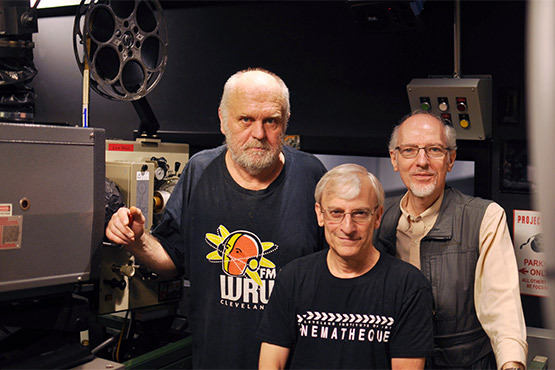
News . Feature Stories . Film event celebrates dimming in projectionist booth
News
July 28, 2016
Film event celebrates dimming in projectionist booth
Cinematheque veterans have kept reels turning for decades

Picture credit: Lylah Rose Wolff
Tom Sedlak (left), Mike Glazer and Les Vince in the Cinematheque booth
By Clint O’Connor
The digital revolution has not only sent thousands of film projectors to the dumpster, it has diminished the value of what were once crucial members of the cinematic process: projectionists.
These skilled, seasoned technicians have been largely replaced by hard drives as the precision of showing movies has been reduced to clicking a mouse.
As a tribute to the more than 100-year tradition of film projection, the Cleveland Institute of Art Cinematheque will host a special evening at 8:15 p.m. on Sat., August 6 featuring a screening of Peter Flynn’s new documentary “The Dying of the Light.” The film is one of six special movies showing between August 4 and 7 that celebrate the Cinematheque’s 30thanniversary at the CIA.
Flynn’s compelling and informative film celebrates the men and women of the projection booth while lamenting the end of an era. The writer-director will be at CIA to take the stage of the Peter B. Lewis Theater for a post-film discussion, along with three longtime operators: Cinematheque projectionists Les Vince, Tom Sedlak, and Mike Glazer.
Vince and Sedlak have been showing films for director John Ewing since the Cinematheque was founded 30 years ago. Glazer is a 16-year veteran. All three fell in love with film at a young age.
“Ever since my mother used to take me to the movies back in Budapest, Hungary, I was always fascinated by what made them work,” said Vince. “Who was behind that door where the light was coming from? Who put all those wonders on screen? It was the one job I always wanted to do.”
Sedlak started projecting films at Brush High School in Lyndhurst as a member of the AV Club in the 1960s.
“We had what was known as the ‘Noon Movie.’ It was 35mm, and every day we would show one reel, about 20 minutes’ worth. We charged a nickel admission,” Sedlak said.
Glazer, who is also a film collector, was similarly smitten in high school. “They would show old movies from the 1930s at Heights High [in Cleveland Heights] and I was hooked.” He still prefers movies either from the ’30s, or set in the ’30s. “Two of my favorites are ‘Bonnie and Clyde’ and ‘The Sting.’ ”
His commitment to movies reaches beyond the Cinematheque. In his basement screening room at home, Glazer has 35mm and 16mm projectors.
“The Dying of the Light,” which Ty Burr of The Boston Globe called “an elegy to a century of watching movies and to the craftspeople who made it possible,” showcases a wide array of projectionists and vintage theaters, and takes us on a deep dive of relevant artifacts: magic lanterns, carbon arcs, and highly flammable nitrate prints. (The documentary also visits Boston Light & Sound, the renowned company that installed the sound and projection systems in the Peter B. Lewis Theater.)
The Cinematheque is unique. While it has embraced the digital age with a 4K digital projector and 7.1 Dolby sound, it also shows movies in their original formats on 35mm projectors, usually one a weekend. It allows the projectionists to juggle old and new.
“The new digital files are pristine,” said Sedlak. “No jittering. No scratches. It’s a little like the difference between CDs and vinyl. You miss those imperfections.”
Vince misses some aspects of the Cinematheque’s former home on East Boulevard, but he is warming up to the new digs.
“I like the environment here. It’s cleaner, and the booth is roomier and cooler,” he said. “But I am also nostalgic for running films. It’s a beautiful medium. There’s something about the physical touch. You can actually see the frame, the soundtrack, where the cue marks are. I even miss the smell of film.”
Even though “The Dying of the Light” shares Vince’s sense-satisfying enthusiasm for actual prints, the documentary will be projected digitally at the Cinematheque.
“It doesn’t take any skill anymore,” said Sedlak. “You just click on a mouse. It’s all pre-set. It’s just another trade that has gone by the way.”
As for marking 30 years of running films at CIA, he said, “It’s kind of amazing. You just get into a groove. But at least it keeps me out of trouble on weekends.”
Latest Headlines view all
-
April 02, 2024
Cleveland Institute of Art students partner with Progressive Art Collection to exhibit Ready, Set, Relay! -
March 04, 2024
Cleveland Institute of Art announces Curlee Raven Holton Inclusion Scholar Program -
November 06, 2023
Collision of art and artificial intelligence creates murky waters for artists, curators and educators
Questions?
For more information about this or other CIA news, contact us here.
Social Feed